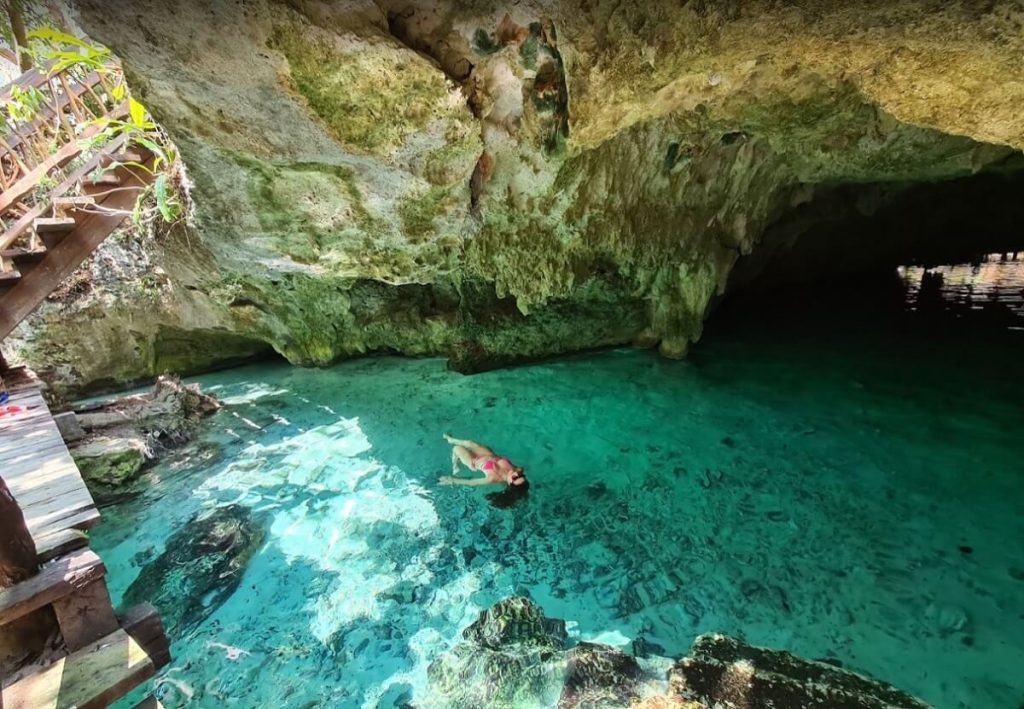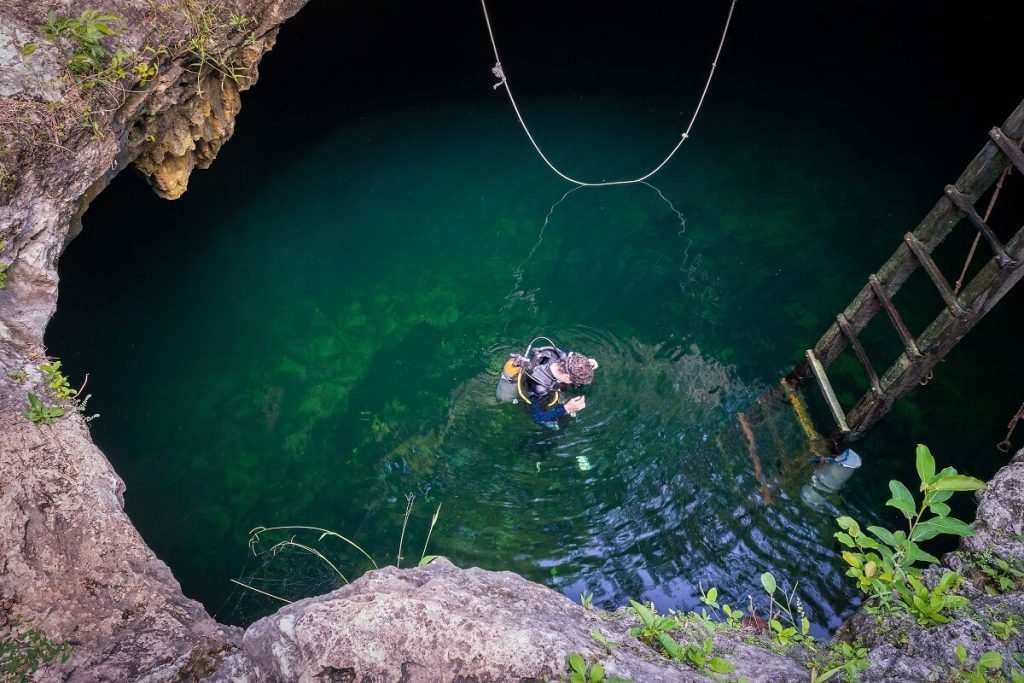Welcome to the captivating world of spectacular cenotes in Tulum where turquoise waters and ancient secrets await. While Tulum is renowned for its pristine beaches and vibrant nightlife, it is the hidden underground rivers and cenotes that truly steal the show. These natural sinkholes, created by collapsed limestone, offer a mesmerizing glimpse into an enchanting subterranean paradise. Imagine diving into crystal-clear waters, surrounded by dramatic stalactites and stalagmites, as rays of sunlight filter through the caverns above.

Whether you are a seasoned cave explorer or a curious traveler, cenotes en Tulum offer an unforgettable experience that goes beyond the typical beach getaway. Join us as we delve into the mysteries of these ancient formations, uncovering their cultural significance and exploring the incredible biodiversity that thrives within their depths. Get ready to be amazed by Tulum’s hidden gems, as we embark on a journey to discover the breathtaking beauty of its cenotes.
Table of Contents
What are cenotes?
Cenotes are natural sinkholes that form when the roof of an underground river or cave collapses, revealing a pool of freshwater beneath the surface. The word “cenote” comes from the Mayan word “dzonot,” which means “sacred well.” These geological wonders are found throughout the Yucatan Peninsula, with Tulum being home to some of the most stunning examples.
Cenotes appear in a variety of forms, from open-air swimming ponds to partially or entirely enclosed cave systems. Thanks to the filtration process that takes place as rainfall seeps through the limestone, the water in cenotes is remarkably pure and frequently exhibits gorgeous colours of blue and green.
Cenotes have considerable cultural value in addition to being visually appealing. Cenotes were used for a variety of rites and ceremonies in the pre-Columbian Mayan culture because they were regarded as sacred places. They were regarded as the homes of the gods and thought to be entrances to the underworld. Cenotes are still cherished by the local population today and are seen as significant natural resources that must be safeguarded.
The significance of Tulum cenotes history and culture
Cenotes have played a significant role in the history and culture of Tulum. The ancient Mayans considered cenotes to be sacred, and many of their cities and settlements were built near these natural wonders. Cenotes provided the Mayans with a reliable source of freshwater in the otherwise dry and arid environment of the Yucatan Peninsula. They were also used for religious ceremonies and as a means of communication with the gods. Sacrificial offerings, such as precious objects and even human remains, have been discovered in cenotes, further highlighting their importance in Mayan culture.
Today, cenotes continue to hold cultural significance for the people of Tulum. They are considered sacred sites and are often used for spiritual ceremonies and rituals. The local community is actively involved in the preservation and conservation of cenotes, recognizing their importance not only as natural wonders but also as a part of their cultural heritage.
Types of Cenotes in Tulum
Tulum is home to a diverse range of cenotes, each with its own unique characteristics and charm. Here are some of the most common types of cenotes found in the region:
Open Air Cenotes
These are the most common type of cenotes and are characterized by their open-air pools. These cenotes offer a stunning view of the surrounding landscape and are often surrounded by lush vegetation. They are perfect for swimming, snorkeling and enjoying the natural beauty of the cenotes.
Semi Open Cenotes
These cenotes are partially enclosed, with a portion of the roof still intact. They offer a mix of open-air and cave-like environments, providing a unique experience for visitors. The partially enclosed nature of these cenotes creates an otherworldly atmosphere, with light filtering through the cracks in the ceiling, illuminating the crystal-clear waters below.
Cave Cenotes
These cenotes are fully enclosed within caves and offer a true underground adventure. Exploring these cenotes requires some level of cave diving or snorkeling experience, as they can be dark and challenging to navigate. However, the effort is well worth it, as cave cenotes often reveal hidden chambers and intricate rock formations that are simply awe-inspiring.
Exploring the Best Cenotes in Tulum
Tulum boasts an impressive selection of cenotes, each with its own unique features and attractions. Here are some of the most popular cenotes to visit in the area:
Gran Cenote

Gran Cenote, which is not far from the Tulum ruins, is a must visit for cenote fans. This cenote offers a combination of open air pools and cave like passages, making it ideal for both swimming and snorkeling. The crystal clear waters of Gran Cenote provide excellent visibility, allowing visitors to admire the underwater rock formations and diverse marine life.
Cenote Dos Ojos

Translated as “Two Eyes” in English, Dos Ojos is a cenote system consisting of two connected cenotes. Cenote dos ojos is known for its extensive cave network, offering a thrilling experience for cave divers and snorkelers. The underwater cave system of Dos Ojos is considered one of the most intricate and beautiful in the world, with stunning stalactite formations and mesmerizing light effects.
Cenote Calavera

Also known as the “Temple of Doom”. Cenote Calavera is an adrenaline-pumping cenote that offers a unique cliff-jumping experience. This cenote features three interconnected sinkholes of varying depths, making it perfect for thrill seekers looking for an exciting adventure. Whether you choose to jump off the cliffs or explore the underwater caves, Cenote Calavera is sure to leave you with lasting memories.
Cenote Azul

Cenote Azul is a stunning natural swimming pool located in the heart of the Yucatán Peninsula in Mexico. This beautiful cenote is a popular tourist destination, drawing in visitors from all over the world, thanks to its crystal clear turquoise waters and stunning limestone rock formations. The cool and refreshing waters of Cenote Azul make it the ideal place to escape the hot Mexican sun and enjoy a swim or snorkel.
Cenote Zacil Ha

The Yucatan Peninsula in Mexico is home to the natural wonder of Cenote Zacil Ha. The water is deep, clear, and surrounded by rugged terrain and lush vegetation. The Mayan name “Zacil Ha” means “clear water”, and it is evident how this cenote came to have that name. Since the water in the cenote is so pure, you can see all the way to the bottom, where little, vibrant fish are swimming. You can engage in some risk-taking sports here, such as cliff jumping from a height of about 20 feet or scuba diving in the underground river.
Cenote Angelita

One of the most distinctive diving locations in the world, Cenote Angelita is renowned for its fantastical underwater environment. The cenote is formed by a layer of hydrogen sulfide which separates the fresh and saltwater. You’ll notice a rapid difference in warmth and clarity when you pass through this layer as you descend deeper into the cenote. An atmosphere of gloom and beauty is created by the thick layer of leaves that cover the cenote’s bottom. The diving experience is unforgettable and it’s worth the visit for anyone with a passion for diving or a love for adventure! It’s important to note that diving in Cenote Angelita can be dangerous and requires a certain level of experience, so be sure to take all necessary precautions and follow the guidance of an experienced guide.
Cenote Carwash

Cenote Carwash is a natural pit or sinkhole filled with crystal clear blue waters that are perfect for diving and snorkelling. The name “carwash” comes from the fact that it was once used as a place for locals to clean their cars. With its unique underwater caves and limestone formations, divers can experience a whole new world of beauty that can only be found in the cenotes of Mexico.
Cenote Manati

Cenote Manati is a limestone sinkhole that is filled with crystal-clear water, making it an ideal spot for swimming and snorkeling. The cenote is named after the Manati or sea cow, which is a marine mammal that once inhabited the waters of this region. The water in this cenote is incredibly clear and blue, making it a perfect spot for photography enthusiasts. The area around the cenote is also rich in cultural and historical significance, and visitors can learn about the ancient Mayan civilization that once thrived in the region.
Cenote Choo-Ha

Cenote Choo-Ha has crystal-clear waters, which are perfect for swimming, diving and exploring the underwater caves. The stunning rock formations and stalactites offer a truly unique and fascinating experience. Cenote Choo-Ha is surrounded by lush vegetation and wildlife, making it a perfect spot for birdwatching and nature walks. Cenote Choo-Ha is one of the most beautiful cenotes in Mexico!
Safety tips for visiting cenotes in Tulum
While cenotes in mexico offer a magical experience, it’s important to prioritize safety during your visit. Following are some crucial safety advice:
1. Swim only in designated areas: Stick to the areas that are open for swimming and snorkeling. Avoid venturing into restricted or unmarked areas, as they may pose potential dangers.
2. Respect the environment: Cenotes are delicate ecosystems that need to be preserved. Avoid touching or damaging the underwater rock formations and refrain from using sunscreen or other chemicals that can harm the water and marine life.
3. Use proper equipment: If you plan to dive or snorkel in the cenotes, ensure that you have the necessary equipment and that it is in good working condition. If you are a beginner, consider hiring a certified guide to ensure a safe and enjoyable experience.
4. Follow local regulations: Be aware of and adhere to any rules and regulations set by the cenote management or local authorities. These rules are in place to protect both visitors and the cenotes themselves.
5. Stay hydrated: The Yucatan Peninsula can be hot and humid, so make sure to drink plenty of water to stay hydrated. Bring a refillable bottle of water with you and keep it full at all times.
Remember, safety should always be a top priority when exploring cenotes. By following these tips, you can have a memorable and safe experience in Tulum’s stunning cenotes.
Activities to enjoy in cenotes

Cenotes offer a wide range of activities for visitors of all ages and interests. Here are some of the activities you can enjoy in Tulum’s cenotes:
1. Snorkeling: Explore the underwater world of cenotes by snorkeling in their crystal-clear waters. Discover vibrant fish, intricate rock formations and even underwater caves as you glide through the cenote’s depths.
2. Diving: For certified divers, cenotes provide an unparalleled diving experience. Dive through submerged caves, navigate intricate tunnels and witness the breathtaking beauty of the cenote’s underwater landscapes. Whether you are an experienced cave diver or a beginner, Tulum’s cenotes offer diving opportunities for all skill levels.
3. Cliff jumping: If you’re seeking a rush of adrenaline, many cenotes in Tulum offer cliff-jumping platforms of varying heights. Take a leap into the refreshing waters below and experience an exhilarating thrill.
4. Kayaking and paddleboarding: Some cenotes allow visitors to explore their waters by kayak or paddleboard. Paddle through the calm waters of the cenote, taking in the surrounding natural beauty at your own pace.
5. Guided tours: If you prefer a guided experience, there are numerous tour operators in Tulum that offer guided tours of the cenotes. A knowledgeable guide can provide insights into the cenotes’ history, geology and marine life, enhancing your overall experience.
With so many activities to choose from, there is something for everyone in Tulum’s cenotes. Immerse yourself in the natural wonders of these underwater marvels and create lasting memories.
Environmental conservation efforts for cenotes
As cenotes are an integral part of Tulum’s natural and cultural heritage, there are ongoing efforts to preserve and conserve these precious resources. Local organizations, government agencies and the community have come together to protect the cenotes and raise awareness about their importance. Some of the conservation efforts include:
1. Education and awareness programs: Various organizations conduct educational programs and workshops to raise awareness about the cenotes ecological value and the need for their conservation. These programs target both locals and tourists, aiming to foster a sense of responsibility and respect towards the cenotes.
2. Sustainable tourism practices: The tourism industry in Tulum has taken steps to promote sustainable practices that minimize the impact on the cenotes fragile ecosystems. Measures such as controlled visitor access, waste management and responsible snorkeling and diving practices are implemented to ensure the long-term preservation of the cenotes.
3. Scientific research and monitoring: Scientists and researchers are studying the cenotes ecosystems to gain a better understanding of their biodiversity and the potential threats they face. This research helps in designing effective conservation strategies and management plans.
4. Community involvement: The local community plays a crucial role in the conservation of cenotes. Many organizations actively involve the community in conservation efforts, encouraging them to become stewards of these natural wonders. Community-led initiatives include cenote clean-up drives, planting native vegetation and educating the younger generation about the importance of cenote conservation.
By combining these efforts, Tulum aims to ensure the long-term sustainability and preservation of its cenotes, allowing future generations to experience their beauty and significance.
How to plan your cenote adventure in Tulum
Planning your cenote adventure in Tulum can be an exciting and rewarding experience. Here are some tips to help you make the most of your trip:
1. Research and choose your cenotes: Tulum offers a wide variety of cenotes, each with its own unique features. Research the different cenotes available and choose the ones that align with your interests and preferences. Consider factors such as accessibility, activities offered and the level of adventure you seek.
2. Consider hiring a guide: If you are new to cenote exploration or prefer a guided experience, consider hiring a certified guide. A guide can provide valuable insights, ensure your safety and enhance your overall experience by sharing their knowledge of the cenotes history, geology and marine life.
3. Plan your itinerary: Create a flexible itinerary that allows you to explore multiple cenotes while also leaving room for relaxation and other activities. Consider the distance between cenotes and plan your route accordingly to optimize your time and minimize travel.
4. Pack essentials: When visiting cenotes, it’s essential to pack some essentials. These may include sunscreen, a hat, sunglasses, a reusable water bottle, a towel and a change of clothes. Additionally, if you plan to snorkel or dive, ensure you have the necessary equipment or arrange for rental in advance.
5. Respect the cenotes and local culture: As you explore the cenotes, remember to respect the environment and local culture. Follow the rules and regulations set by the cenote management, avoid littering and be mindful of your actions to ensure the preservation of these natural wonders for future generations.
By following these tips, you can plan an unforgettable cenote adventure in Tulum, immersing yourself in the beauty and wonder of these hidden gems.
Conclusion: Uncovering the hidden Beauty of Tulum cenotes
Cenotes in Tulum offer an enchanting escape from the bustling beaches and lively nightlife. These natural wonders invite you to embark on a journey into an underground paradise, where turquoise waters and ancient secrets await. From open-air pools to intricate cave systems, Tulum cenotes offer a diverse range of experiences for visitors of all interests and skill levels.
Beyond their visual allure, cenotes hold immense cultural significance, with the ancient Mayans considering them sacred gateways to the underworld. Even today, cenotes continue to be revered by the local community and are regarded as important natural resources that need to be protected and preserved.
As you explore best cenotes in Tulum, remember to prioritize safety, respect the environment and embrace the opportunity to learn and engage with the rich history and biodiversity that thrives within these subterranean marvels. So, dive into the crystal-clear waters, marvel at the intricate rock formations and immerse yourself in the captivating beauty of Tulum cenotes.




No Responses